A simple recipe for homemade bar dish soap that gets your dishes sparkling clean. One of the most practical cold process soap recipes this bar combines the cleansing power of coconut oil with the lathering of castor oil. With just a few ingredients, it’s a great money-saving home DIY. Add lemon fragrance for a fresh scent.

Homemade Bar Dish Soap
Ingredients
- 1 ounce castor oil
- 29 ounces coconut oil
- 5.41 ounces lye
- 8 to 11 ounces water
- 1 tablespoon fragrance oil optional
Save This Recipe
You'll join my email list which you will love. And if you don't, unsubscribe in one click. ❤️
Instructions
- Make the lye water. Measure the lye and water in separate containers, using a digital scale. Combine the lye and water by adding the lye to the water, then stir until dissolved. The lye solution will shoot up in temperature and become hot. Set aside to cool in a safe place.
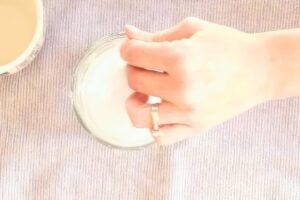
- Melt the oils. Measure the castor oil and coconut oil using a digital scale. Melt over low heat in a stainless steel pot until fully melted and 140 degrees. Set aside to cool in a safe place.

- Blend the components. When the lye water and melted oils have cooled to about 110 degrees, combine them by pouring the lye water into the melted oils. Blend with a stick blender until a thin trace is reached. (The mixture will thicken slightly and no droplets of oil are visible.) Add the fragrance, if using, and stir in by hand.

- Pour into mold. Immediately pour into a soap mold with individual bars. (The soap dries too hard to cut easily if made as a loaf). Remove from the molds after 24 hours and allow to cure 2 weeks more before using. Store the bar in a place that will allow it to dry as much as possible between uses.

Video
Notes
- 96.67% coconut oil
- 3.33% castor oil
- 1% superfat
Cheap but works just as well. Whether you are trying to live sustainably or live frugally, this bar dish soap will help you get there. Store-bought dish soap is shockingly expensive and always comes in big plastic containers. But bar dish soap takes up hardly any room, is packaging-free, and works just as well.
Very cleansing. This recipe is almost all coconut oil, which is very cleansing but drying. I added a small amount of castor oil for extra lather because everyone likes bubbles while washing the dishes. (For an even stronger soap, for use on laundry stains, you can try my homemade cleaning soap.)
You can add a fragrance of your choice. If you want to add fragrance, you definitely can! Just keep in mind that this will be touching plates, where you eat your food. Because of that, I chose to use orange oil instead of a synthetic fragrance oil. If you want to use essential oil, make sure you look for one that won’t fade as the soap cures. (10x orange is a good one.)
It is calculated to be a 1% superfat. This just means that there is very little extra moisture left over from the oils. They are almost all saponified or turned into soap.
Because of the low superfat and high amount of coconut oil, this soap is not suitable for the skin. But it leaves dishes sparkling clean! (Here is my best shower soap recipe.)

Equipment
Proctor Silex Electric Immersion Hand Blender with Detachable Dishwasher Safe Handheld Blending Stick, 2-Speeds, 150 Watts, White (59739)X-Haibei Celtic Knot Design Rectangle Silicone Glossy Soap Mold Heavy Big Soap Bar MakingNOW Essential Oils, Lemon Oil, Cheerful Aromatherapy Scent, Cold Pressed, 100% Pure, Vegan, Child Resistant Cap, 4-OunceSnowkingdom 4 Pack Beige Soap Saver Draining Lift Pad 2.9
- Stick blender
- Digital scale (I use this one with a percentage function)
- Spare cups and a spare pot
- Safety goggles and gloves
- Individual bar soap mold (I used two of these bar soap molds)
Substitutions
- Olive Oil: If you prefer a milder soap, you can substitute some of the coconut oil with olive oil in your soap recipe.
- Citric Acid: To help with hard water issues, you can add a small amount of citric acid to your soap mixture.
- Baking Soda: For added scrubbing power, consider sprinkling a bit of baking soda on your dishes before washing.
Instructions
Step One: Measuring and Combining Ingredients
Begin by measuring out the lye and water separately, using a digital scale. Combine them by adding the lye to the water (“snow floats on the lake”). Stir until the lye fully dissolves, and set aside in a safe place.
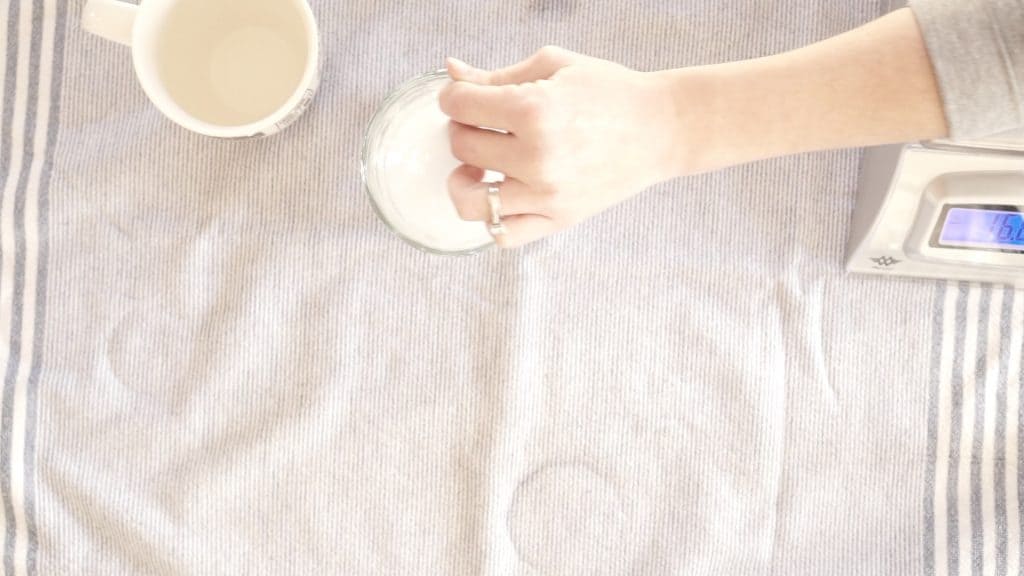
While the lye water is cooling, measure out the coconut oil and castor oil on the scale. They should technically be measured separately, but I just add them right to the pot I am melting them in.
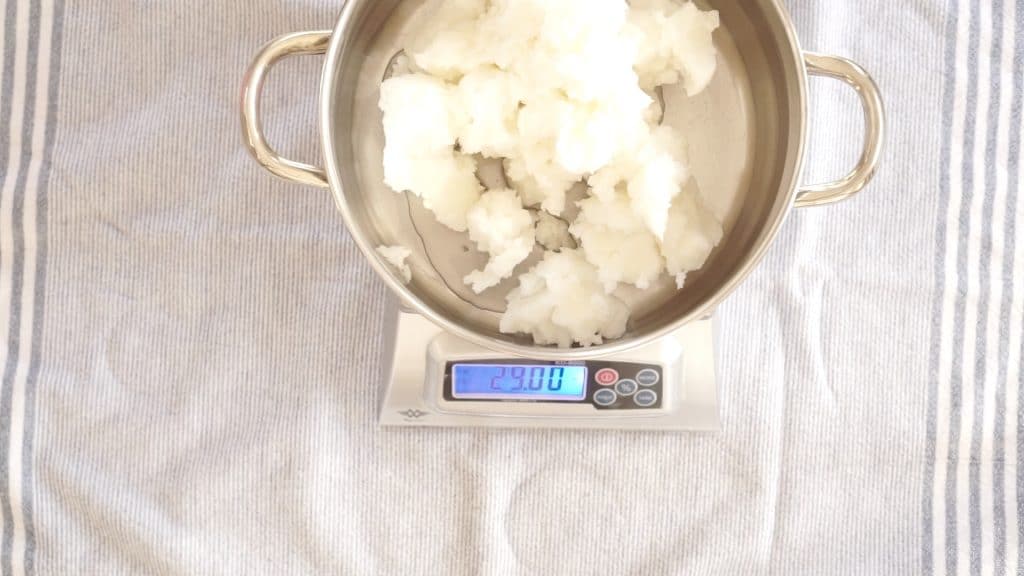
Step Two: Melt Oils and Let Them Cool
Set the oils on the stove to melt on low, until they are fully melted and 140 degrees.

Now you need to wait for everything to cool down. This will take two to three hours. Both components should be about 100-110 degrees before you blend them. Ideally, they will be close in temperature, less than ten degrees apart.
Step Three: Blend
To blend, pour the lye water into the pot with the melted oils. Blend with your stick blender until a light trace is formed. That means that the blender leaves a trail (or “trace”) when it is dragged through the batter. You shouldn’t see any visible droplets of oil. It usually takes about 5 minutes of blending.
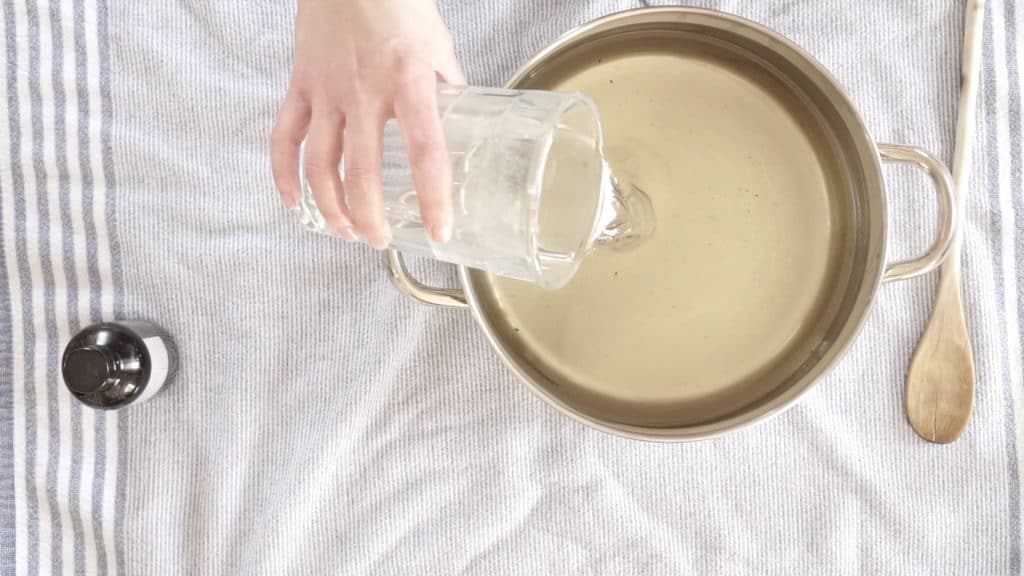
It will look like this:

If you are adding fragrance, go ahead and do it now and stir it in by hand.
Step Four: Mold
Immediately pour into your soap molds and allow to harden for 24 hours before removing from the mold.

Let it cure for two weeks before using, otherwise it will dissolve too quickly.
FAQs
No. If it does not contain lye, it is not soap.
Some fragrances and essential oils last longer than others. You can try a bit of kaolin clay to help the fragrance stick. In general, a designated soap fragrance oil will last longer than essential oil.
As long the recipe is accurate, you can certainly double it!
Yes! Any store-bought cold-process soap is quite expensive.
Yes, you can use different essential oils in your dish soap recipe. Citrus oils like lemon essential oil are a good choice for a fresh scent.
If you notice excess water in your soap batter, continue blending until it reaches the right consistency. This can take a couple of days to fully dry and cure.
Using homemade solid bar dish soap helps reduce the use of wasteful plastic bottles commonly found in liquid soap.
Making your own homemade bar dish soap is a simple and effective way to clean your dishes while saving money and reducing plastic waste. With just a few ingredients and some basic equipment, you can create a soap that works just as well as store-bought options. Plus, you have the flexibility to customize the fragrance and ingredients to your preference. Give this recipe a try, and enjoy the benefits of a natural, eco-friendly dish soap in your kitchen. Happy soap-making!



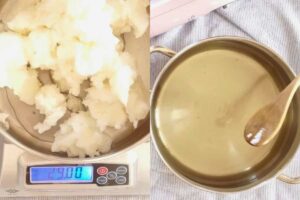
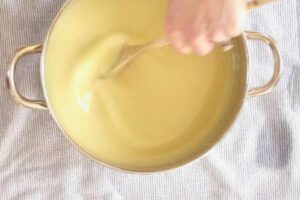
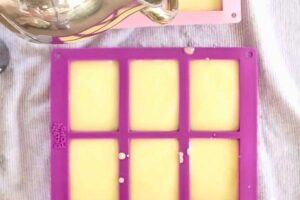




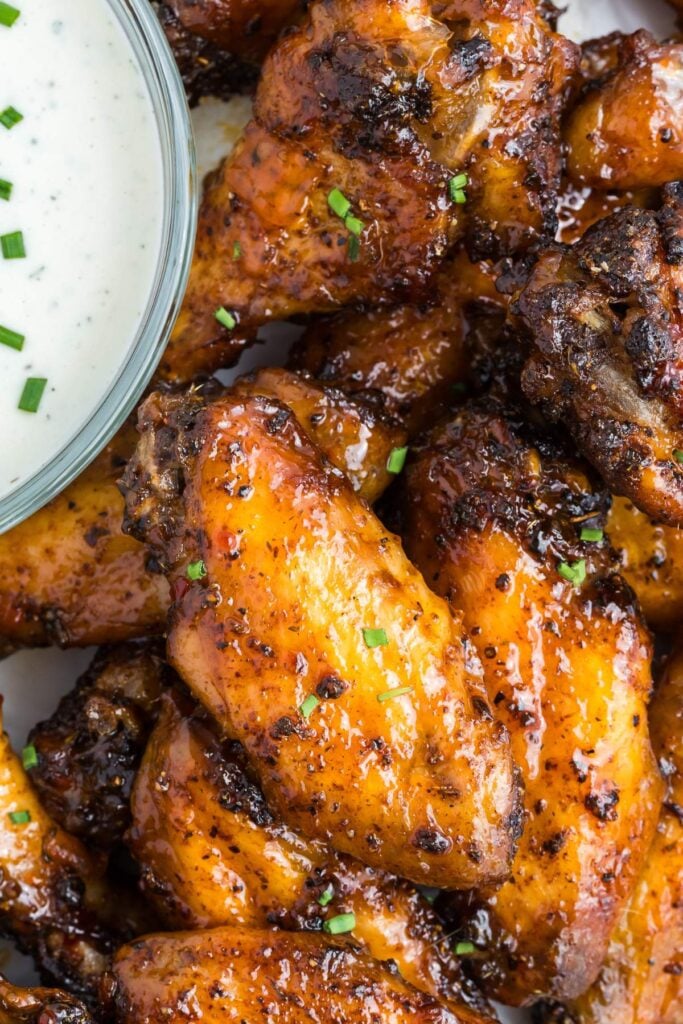
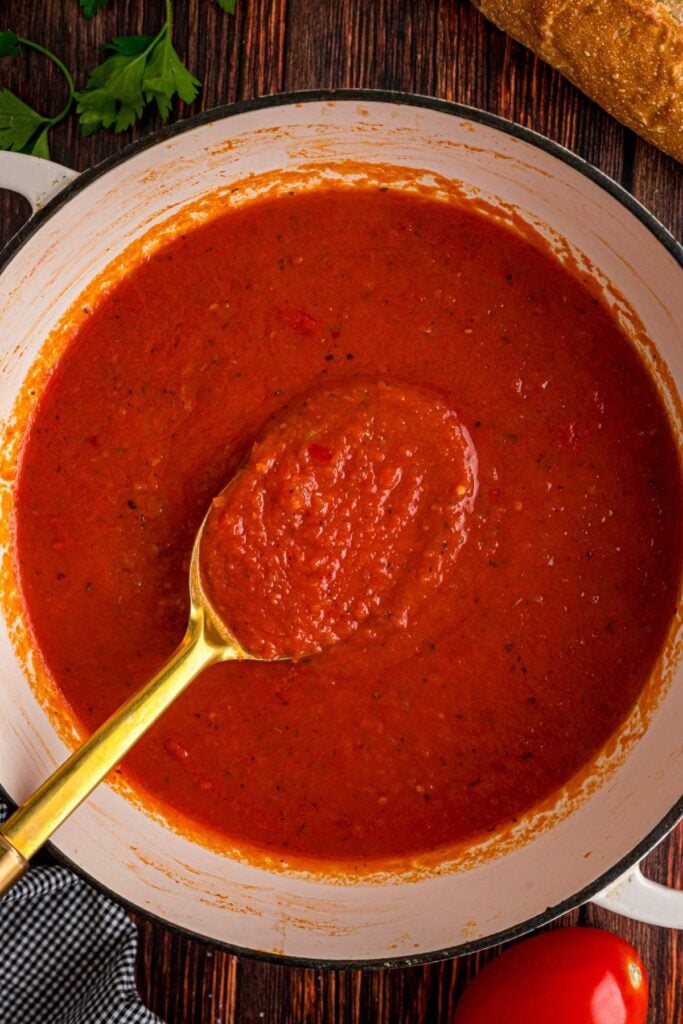

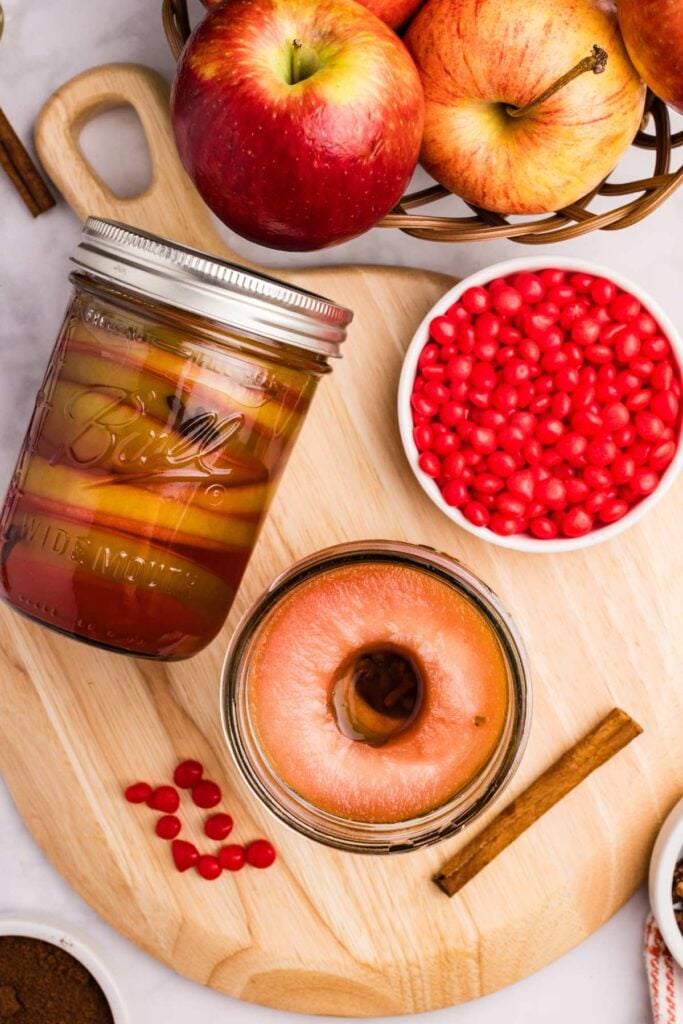
can i replace castor oil with any other type of oil?
its just for extra lather, you can substitute olive oil or simply leave it out. just run it through a lye calculator to make sure the lye value doesn’t change
Thank you! I can’t wait to try this. I didn’t see how many ounces of water so I went to SoapCalc and got it all figured out. Thanks for sharing your gifts and talents with us!
I want to make this recipe but when I am using the SoapCalc, it is asking for the % of Water to Lye, I don’t see that, I need to what percentage water should I use.
hmm. is it asking you for superfat percentage? you should just be able to enter the oil and it spits out the water and lye. I use 1% superfat for this recipe (because its for dishes)
no, it was asking for the water, lye or the water lye ratio, but i figured that out. I just noticed the soap I made it cracked, I mixed the ingredients at around 100F -105F but i did mix it almost 7 minutes, it took longer for it to reach trace. I am wondering since I poured it in a loaf style mold. not sure why, I am going to check the pH level in the next few days to see, do you know if the pH should be between 9-10. then it should be okay to use.
The water/lye ratio is going to determine how fast the soap will process. More water, longer times to process.
It’s also a value to determine the time to get the trace, more water it’s gonna take longer times to trace.
This value is not related to superfst, are independent each other
What size stainless steel pot are you using? And, can you suggest a good pot (without aluminum) for this project? I’m struggling to find one that isn’t super expensive. Thanks…I’m looking forward to trying this out soon.
Thank you for the detailed instruction. But I do have one question.
I’m finding that after my dishes and letting them air dry, I have a white water marks left behind. I thought it was because I wasn’t rinsing well enough. opps. but even after I rinse really well its still there.
If you have any insight on why this is happening – I would highly appreciate it.
Thank you
Can you melt this soap? I’d like to keep it in a bowl type dish by the sink but this recipe makes a lot from what I can tell. I thought it might be nice to make it into little bars I could just melt and pour into my dish as it empties.
Hi, I do love making soap! One suggestion is to pour this dish bar soap into bowls and let it dry. You would then use the bowl near your sink with a scrub brush. It would also be ready to gift easily! Thank you for your recipe.
what a great idea! I’ll do that next time I make these!
Hello,
Want to know if I can use olive oil instead of coconut oil because I will soon not have access to coconut oil and olive oil is local to me. Also, how can I add essences to this? Thank you for publishing this!
Elizabeth, the coconut oil makes for a hard, cleansing bar ideal for dishes. you can experiment with an olive oil bar but it will need a different amount of lye and will be your own custom recipe. you will need to go to a lye calculator to figure out how much lye you need. the thing about oliveoil soaps is they take a very, very long time to harden (months!). so it might not be ideal for you. as far as adding essential oils, you mix them in by hand after the oils and lye batter have formed a batter.
Thank you so much for your help! If I am using the coconut oil, does it matter if I use extra virgin or not?
no you don’t need that! in fact it would make these bars very expensive. look for one that’s non food grade, specifically for soap. I like this source: http://nurturesoap.com?aff=326
Katie, Thank you for your recipe!
I do not know how to measure 5 2/5 oz
What would the amount I would read on my digital scale be?
Thank you
Jane
hi Jane, I’m not sure where you are seeing that. here is the list of ingredients and measurements. maybe they are displaying differently on your screen>
1 ounce castor oil
29 ounces coconut oil
5.41 ounces of lye
8 to 11 ounces of water
1 tablespoon fragrance oil (optional)
Haven’t tried it yet but just made this according to the recipe. It looks super white and probably is very cleansing. I soaped at 85 degrees and it started cracking from getting too hot so I threw it in the freezer for an hour then in the fridge for a few hours. It’s going to be super hard so i’ll try to slice it in a few more hours. Excited to start washing my dishes with it!
Hi I wondered if there’s any way to blend this in a regular blender because I don’t have an immersion blender right now?
Thanks!
sorry Tabitha 🙁 it would be really dangerous because the lye solution is so caustic. if it splattered it would harm you very badly. some people have had success whisking my hand, but it takes a long time and it’s never worked for me.
Hi Katie. I would like to try your homemade bar dish soap recipe. However, being an Asian, my cooking involves lots of greasy utensils n cutlery. Eventhough high percentage of coconut oil is great for cutting down the oil, I m worried about my dry sensitive skin. How many percentage of olive oil (or any other suitable oil) should I add to the recipe or increase the superfat in order to make a less drying yet cleaning dish soap bar?
I would try 60 coconut 40 olive and do a 2% superfat. Olive oil soaps have a very long cure time so give it a month before you use it! But it should still rinse clean and be very cleansing 🙂
Thank you for your prompt reply. Should I still add castor oil? If yes, how many percentage please?
Yes, sorry! Do 60 coconut, 38 olive, 2 castor
Help! my soap won’t come to trace! Advice?
hi! i made this recipe several times and have loved it!- that being said I made it today and after I combined it and put it in the molds, it got REALLY hot. WAY hotter than usual… it also is kinda puffing up at the top. Advice? Any possible reasons why? Also, another batch I made cracked when they were curing (it might have been because something fell on it or other natural causes) but I wanted to know if I did something wrong. Thanks!
Hi Skye! It’s a hard soap so if it gets disturbed while its curing it will definitely crack! no worries, it will still work just fine. As far as as the hot batch, there are a few possible causes: 1. your ingredients were too hot when you blended (This will sometimes cause an overflow). 2. your soap got hot AFTER you poured it into the molds and it’s going through gel phase (looking translucent and getting super hot). this would happen if the room is warmer than usual, but typically would only only happen at 85 degrees or above. Either way, the final result should still be fine!
So I just made the soap and it cracked as well, I mixeed everything 104F, not sure why but looking at it is is really hot I did cover it with a plastic sheet. it is 75F in my house.
I made the soap and allowed it to cure. I am so excited to start using it. What do you do when soaking dishes? Do you use the same bar soap?
hi Stephanie!
I just hold the bar under running water and let the pot fill up with bubbles
Hello there! I wanted to make this recipe in a loaf mold. Would it set up and dry out the same or would it mess up the recipe? Also, I love this blog! <3
Hi Ellie, so it sets up SUPER hard and I think it would be too hard to cut! You could try it, but I just don’t know if you’ll be able to slice it into bars. Maybe if you cut it into it early? And thank you! 🙂
Thank you!!!!
Haha sorry one more question: have you ever used a circular mold or mini mason jars? Would those work? I’m just worried the mold used in the video might be too small or run out too quickly…thanks!
I’ve never used a mini mason jar! it’s always nice to have a spare mold for an extra amount of soap that won’t fit in the mold. you can always just have a really small box lined with wax paper to catch any extra 🙂
First I would like to thank you for giving us free recipient and taking the time to make videos and blogs. I truly appreciate it. I made this soap and find it a beautiful bar. Thank you again. I do have a question. My sink gets cloudy and certain pot as well. Not all pots. I’m Wondering if I did something wrong or maybe you can give me some advice on what could be the cause. Maybe my scale didn’t measure properly and I have too much oil or lye?
hmm interesting… I’m not sure what the cause could be! is there a certain material that tends to not rinse clean? I’ve never had that problem, but I do use VERY hot water, which helps. the only thing I could think is maybe too much oil… there should be hardly any residue because the superfat is so low in this soap.
I’m going to buy a new scale and remake the soap. Thank you for responding back so quickly.
Can the added essential oils at the end cause this? I don’t use fragrant oils.
it’s possible! I used orange essential oil with no problem though! do you have hard water by the way?
I couldn’t reply under your last response so I will respond here. No, I don’t have hard water. I used orange and lemongrass essential oil.
You bring up a good question. If there is hard water what would be the changes to make a dish soap for hard water?
Just that hard water and bar soap can lead to soap scum, so you have to clean more often. This isn’t such a problem with detergents. One of the downsides of real soap.
You make this look so simple! I think this should be a goal of mine for 2020!
I think I really need to put soap making on my goals list for 2020! My oldest daughter is so interested in learning how! You make it look simple!
Soap looks like so much fun to make! Thanks for the great tutorial!